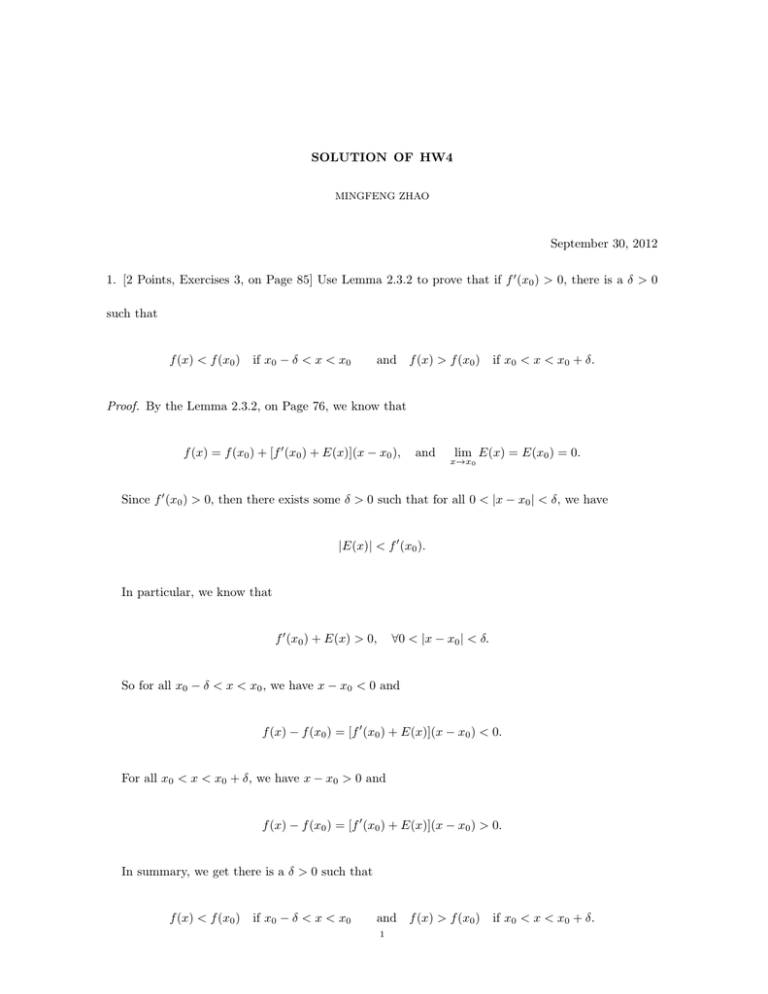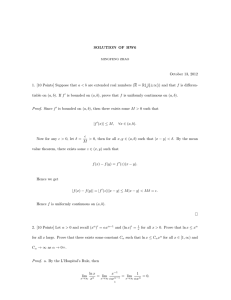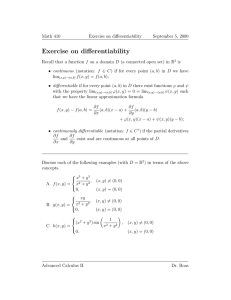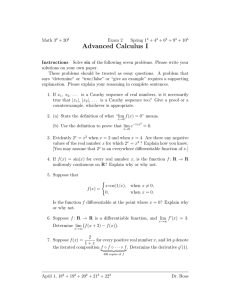SOLUTION OF HW4 September 30, 2012
advertisement

SOLUTION OF HW4
MINGFENG ZHAO
September 30, 2012
1. [2 Points, Exercises 3, on Page 85] Use Lemma 2.3.2 to prove that if f 0 (x0 ) > 0, there is a δ > 0
such that
f (x) < f (x0 )
if x0 − δ < x < x0
and f (x) > f (x0 )
if x0 < x < x0 + δ.
Proof. By the Lemma 2.3.2, on Page 76, we know that
f (x) = f (x0 ) + [f 0 (x0 ) + E(x)](x − x0 ),
and
lim E(x) = E(x0 ) = 0.
x→x0
Since f 0 (x0 ) > 0, then there exists some δ > 0 such that for all 0 < |x − x0 | < δ, we have
|E(x)| < f 0 (x0 ).
In particular, we know that
f 0 (x0 ) + E(x) > 0,
∀0 < |x − x0 | < δ.
So for all x0 − δ < x < x0 , we have x − x0 < 0 and
f (x) − f (x0 ) = [f 0 (x0 ) + E(x)](x − x0 ) < 0.
For all x0 < x < x0 + δ, we have x − x0 > 0 and
f (x) − f (x0 ) = [f 0 (x0 ) + E(x)](x − x0 ) > 0.
In summary, we get there is a δ > 0 such that
f (x) < f (x0 )
if x0 − δ < x < x0
and f (x) > f (x0 )
1
if x0 < x < x0 + δ.
2
MINGFENG ZHAO
2. [2 Points, Exercises 7, on Page 85] Suppose that c0 (0) = a and s0 (0) = b where a2 + b2 6= 0, and
c(x + y)
= c(x)c(y) − s(x)s(y)
s(x + y)
= s(x)c(y) + c(x)s(y)
for all x and y.
a. Show that c and s are differentiable on (−∞, ∞), and find c0 and s0 in terms of c, s, a and b.
b. Find c and s explicitly.
Proof. a. For any x ∈ R and fixed, for any y ∈ R\{0}, then
c(x + y)
= c(x)c(y) − s(x)s(y)
c(x)
= c(x)c(0) − s(x)s(0)
s(x + y)
= s(x)c(y) + c(x)s(y)
s(x)
= s(x)c(0) + c(x)s(0).
Then, we have
c(x + y) − c(x)
y
=
[c(x)c(y) − s(x)s(y)] − [c(x)c(0) − s(x)s(0)]
y
= c(x) ·
s(x + y) − s(x)
y
=
s(y) − s(0)
c(y) − c(0)
− s(x) ·
y
y
[s(x)c(y) + c(x)s(y)] − [s(x)c(0) + c(x)s(0)]
y
= s(x) ·
c(y) − c(0)
s(y) − s(0)
+ c(x) ·
.
y
y
Since c0 (0) = a and s0 (0) = b, that is,
c(y) − c(0)
= a,
y→0
y
lim
and
s(y) − s(0)
= b.
y→0
y
lim
SOLUTION OF HW4
3
Hence, we know that
lim
c(x + y) − c(x)
y
= c(x) · a − s(x) · b = ac(x) − bs(x)
lim
s(x + y) − s(x)
y
= s(x) · a + c(x) · b = as(x) + bc(x).
y→0
y→0
Hence c(x) and s(x) are differentiable on (−∞, ∞), c0 (x) = ac(x) − bs(x) and s0 (x) = as(x) + bc(x)
for all x ∈ R.
b. Since c0 (0) = a and s0 (0) = b, then
a = ac(0) − bs(0),
and b = as(0) + bc(0).
That is,
−b
c(0) a
=
·
b
s(0)
a
a
b
.
Since a2 + b2 6= 0, then
c(0)
=
s(0)
1
2
a + b2
a
·
−b
b
a
·
b
a
1
a2 + b2
=
=
a2 + b2
·
−ab + ab
1
.
0
Hence, c(x) and s(x) satisfy the following ODE system:
0
c(x)
a
=
s(x)
b
−b
c(x)
·
a
s(x)
and
c(0) 1
=
.
s(0)
0
4
MINGFENG ZHAO
a
Let’s compute the eigenvalues of
b
−b
, that is,
a
λ−a
det
−b
b
λ−a
= (λ − a)2 + b2 = 0.
Hence, we get λ = a ± ib. Let’s solve the following
λ−a
−b
y1 ±ib
b
=
·
−b ±ib
y2
λ−a
b
y1 0
.
=
·
0
y2
Case I: λ = a + ib with b 6= 0, then
y1
i
= y2 ·
y2
1
Case II: λ = a − ib with b 6= 0, then
−i
y1
= y2 ·
1
y2
So when b 6= 0, we know that there exists some A, B such that
c(x)
i
−i
= Ae(a+ib)x ·
+ Be(a−ib)x ·
s(x)
1
1
and
Hence, we get
i
−i 1
A·
+B·
=
1
1
0
That is, we get
i(A − B)
A+B
1
= .
0
.
c(0) 1
= .
s(0)
0
SOLUTION OF HW4
5
Which implies that
i
A=− ,
2
and B =
i
.
2
Hence, we get
12 e(a+ib)x + 12 e(a−ib)x
c(x)
=
s(x)
− 2i e(a+ib)x + 2i e(a−ib)x
eax cos bx
=
eax sin bx
.
That is, c(x) = eax cos bx and s(x) = eax sin bx.
If b = 0, since a2 + b2 6= 0, then a 6= 0. Hence we get c0 (x) = ac(x) and s0 (x) = as(x), which implies
that
c(x) = c(0)eax = eax
and s(x) = s(0)eax = 0.
In summary, we know that
c(x) = eax cos bx
and s(x) = eax sin bx.
3. [2 Points, Exercises 13, on Page 86] What is wrong with the “proof” of the chain rule suggested
after Example 2.3.3? Corrected it.
Proof. If g(x) ≡ g(x0 ) in a neighborhood of x0 , then
f (g(x)) − f (g(x0 ))
g(x) − g(x0 )
make no sense.
Correction: Assume that g(x) 6= g(x0 ) in a neighborhood of x0 , then the proof works. In fact, since
f is differentiable at g(x0 ), then
f (t) − f (g(x0 )) = [f 0 (g(x0 )) + E(t)][t − g(x0 )],
6
MINGFENG ZHAO
where
lim E(t) = E(g(x0 )) = 0.
t→g(x0 )
So we know that
lim
t→g(x0 )
f (t) − f (g(x0 ))
= f 0 (g(x0 )).
t − g(x0 )
Replacing t be g(x) since g(x) 6= g(x0 ) for all x 6= x0 in a neighborhood of g(x0 ), then we get
lim
x→x0
f (g(x)) − f (g(x0 ))
= f 0 (g(x0 )).
g(x) − g(x0 )
4. [2 Points, Exercises 14, on Page 86] Suppose that f is continuous and strictly increasing on [a, b].
Let f be differentiable at a point x0 in (a, b), with f 0 (x0 ) 6= 0. If g is the inverse of f , show that
g 0 (f (x0 )) =
1
f 0 (x
0)
.
Proof. Since f is strictly increasing on [a, b], then f (a) < f (b). Since f is continuous on [a, b], then
f ([a, b]) = [f (a), f (b)] and g : [f (a), f (b)] → [a, b].
Claim I: g is continuous on [f (a), f (b)].
For any yn , y0 ∈ [f (a), f (b)] such that yn → y0 as n → ∞. Let xn = g(yn ) and x0 = g(y0 ). We
want to show that xn → x0 as n → ∞, otherwise, there exists some 0 > 0 such that there exists a
subsequence of xn , without loss of generality, assume xn itself such that
|xn − x0 | ≥ 0 ,
∀n ≥ 1.
In the sequence xn , we can choose a subsequence without loss of generality, assume xn itself such
that
x n − x 0 ≥ 0 ,
∀n ≥ 1,
or xn − x0 ≤ −0 ,
Without loss of generality, we assume
x n − x 0 ≥ 0 ,
∀n ≥ 1.
∀n ≥ 1.
SOLUTION OF HW4
7
Hence we get
x n ≥ x 0 + 0 ,
∀n ≥ 1.
Since f is continuous and strictly increasing, then
yn = f (xn ) ≥ f (x0 + 0 ) > f (x0 ),
∀n ≥ 1.
Which contradicts with yn → y0 as n → ∞. Hence we must have xn → x0 as n → ∞. Therefore,
g is continuous.
Claim II: x → x0 if and only if f (x) → x0 .
If x → x0 , since f is continuous, then f (x) → f (x0 ). On the other hand, if f (x) → f (x0 ), applying
g on both sides, since g is also continuous, then x = g(f (x)) → x0 = g(f (x0 )).
Since f 0 (x0 ) 6= 0, then f 0 (x0 ) > 0. By the result of the Problem 1, we know that there exists some
δ > 0 such that f (x) 6= f (x0 ) for all 0 < |x − x0 | < δ. Hence, we know that
g(f (x)) − g(f (x0 ))
f (x) − f (x0 )
=
=
→
x − x0
f (x) − f (x0 )
1
f (x)−f (x0 )
x−x0
1
f 0 (x0 )
as x → x0 ⇐⇒ as f (x) → f (x0 )
Since f is increasing and g is continuous.
Hence, we know that g 0 (f (x0 )) exists and g 0 (f (x0 )) =
1
.
f 0 (x0 )
5. [2 Points, Exercises 16, on Page 86] Show that f (a+) and f (b−) exists if f 0 is bounded on (a, b).
Proof. Since f 0 is bounded, then there exists some M > 0 such that
|f 0 (x)| ≤ M,
Claim I: f is uniformly continuous on (a, b).
for all x ∈ (a, b).
8
MINGFENG ZHAO
For any x, y ∈ (a, b), by the mean value theorem, there exist some z ∈ [x, y] or z ∈ [y, x] such that
|f (x) − f (y)| = |f 0 (z)(x − y)| ≤ M |x − y|.
Which implies that f is uniformly continuous on (a, b). In particular, for any > 0, there exists
some δ > 0 such that for all |x − y| < 2δ, then we have
|f (x) − f (y)| < .
Now for any |x − a|, |y − a| < δ, then |x − y| < 2δ, then
|f (x) − f (y)| < .
That is, f (x) is Cauchy as x → a, Hence f (a+) exists. Now for any |x − b|, |y − b| < δ, then
|x − y| < 2δ, then
|f (x) − f (y)| < .
That is, f (x) is Cauchy as x → b, Hence f (b−) exists.
0
6. [0 Points, Exercises 15, on Page 86] a. Show that f+
(a) = f 0 (a+) if both quantities exist.
0
b. Example 2.3.4 shows that f+
(a) may exist even if f 0 (a+) does not. Give an example where
0
f 0 (a+) exists but f+
(a) does not.
c. Complete the following statement so it becomes a theorem, and prove the theorem: “ If f 0 (a+)
exists and f is
0
at a, then f+
(a) = f 0 (a+).”
0
Proof. a. Recall the definition of f+
(a) and f 0 (a+):
0
f+
(a) = lim
x→a+
f (x) − f (a)
,
x−a
f 0 (a+) = lim f 0 (x).
x→a+
SOLUTION OF HW4
9
In a neighborhood of x, say there exists some δ > 0, we know that f is continuous on [a, a + δ]
and f is differentiable on (a, a + δ]. By the mean value theorem, for any n ≥ 1, there exists some
yn ∈ (a, a + n1 ) such that
f (a +
1
1
) − f (a) = f 0 (yn ) .
n
n
Hence, we get
f 0 (yn ) =
f (a + n1 ) − f (a)
1
n
.
By taking n → ∞, then
f 0 (a+) = f+ (a).
b. Let a = 0 and
f (x) =
x2 + 1,
x 6= 0
0,
x = 0.
0
Then f is not continuous at x = 0, hence f+
(0) does not exist. But f 0 (x) = 2x for all x > 0, and
f 0 (0+) = 0.
0
c. Claim I: If f 0 (a+) exists and f is continuous at a, then f+
(a) = f 0 (a+).
In a neighborhood of x, say there exists some δ > 0, we know that f is continuous on [a, a + δ] and
f is differentiable on (a, a + δ]. By the mean value theorem, for any x, there exists some yx ∈ (a, x)
such that
f (x) − f (a) = f 0 (yx )(x − a).
Hence, we get
f 0 (yx ) =
f (x) − f (a)
.
x−a
By taking x → a, then yx → a. Since f 0 (a+) exists, then
f (x) − f (a)
0
= f+
(a).
x→a+
x−a
f 0 (a+) = lim f 0 (yx ) = lim
x→a
0
Hence f 0 (a+) = f+
(a).
10
MINGFENG ZHAO
Department of Mathematics, University of Connecticut, 196 Auditorium Road, Unit 3009, Storrs, CT
06269-3009
E-mail address: mingfeng.zhao@uconn.edu





